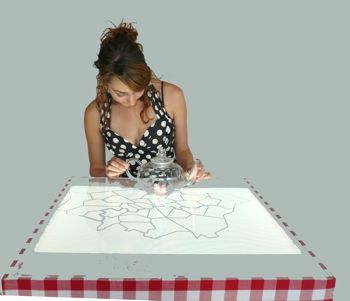A magazine where the digital world meets the real world.
On the web
- Home
- Browse by date
- Browse by topic
- Enter the maze
- Follow our blog
- Follow us on Twitter
- Resources for teachers
- Subscribe
In print
What is cs4fn?
- About us
- Contact us
- Partners
- Privacy and cookies
- Copyright and contributions
- Links to other fun sites
- Complete our questionnaire, give us feedback
Search:
Hacking Teapots

Tea drinking - not the most obvious thing to inspire technological innovation. Despite that, tea pots were the focus for twenty leading female interaction designers, sound artists, bio-artists, architects, performance artists and technologists who met at the Victoria & Albert Museum in London in the Autumn of 2011. The event, called the Chi-TEK Tea Party celebrated the talent and prestige women bring to the mix of art and technology.
The women involved were challenged to mend, modify or enhance an ordinary teapot, turning it into something new. Teapots created for the event included a Suicidal Teapot that hits itself with nails and a group of teapots that moved in synchrony as a flock. There was also a bio-hacked tea cosy made of fabric covered with mould and bacteria grown from tea, biscuits and cake, interacting with the antibiotic effects of green tea.
G.Hack, a women-only hacking club founded by electronic engineering and computer science research students at Queen Mary, University of London were also there. They wanted to do more than just hack a teapot. They wanted a social adventure too. So armed with audio recorders, headphones, video cameras, iPhones and digital cameras, they set off on a mission to record the soundscapes at London's favourite teahouses, enjoying the centuries old tea drinking culture as they went.
The result was a tea table covered with a map of London incorporating a recording from a teahouse in each of the thirty-three London boroughs. They marked the teapot with an infrared LED allowing it to be tracked by a computer vision system. As the teapot is moved around the map, the vision system works out which borough of London it has been placed on and plays the related teahouse soundscape.
The resulting exhibit went on display at the Victoria and Albert Museum. It was the process of creating it that will be most memorable for the G.Hack team, though. It was both physically and technically challenging to create, but in the end they delivered an intriguing interactive experience. It was popular with the museum visitors, inspiring many to share stories about their own favourite teahouses.
Tea. Not just calming, it can be creative too!


